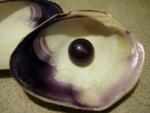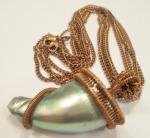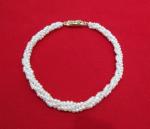Rare Natural Pearls – A Guide to Non-Nacreous Pearl Treasures

Conch Pearl - photo by Kari
Pearls are known to be one of the first gems ever set into jewelry, dating back thousands of years. They were not cultivated by man until the end of the 19th century. All of the pearls owned by international royals, maharajas, celebrities, and socialites throughout history were natural pearls. Today, however, of the small quantity of natural pearls still found in the oceans, those appealing enough to be used in fine jewelry are exponentially more rare. Beautiful natural pearls of the highest quality are one-of-a-kind collectible delights.
Given this rarity and distinctiveness, natural pearls in the modern world are genuine treasures. By definition, a natural pearl forms in a mollusk without any stimulation from mankind. Most of the pearls that we wear now (classic pearl strands, pearl studs and pearl drop earrings, even colorful Tahitian pearls or Fiji Pearls) are nacreous cultured pearls, meaning they were cultivated in a pearl farm by inserting a nucleus into the oyster’s soft mantle tissue. The cultured pearl develops in a natural process, but that process was stimulated by mankind. (For more information on how pearls are formed, click here. For more information about the differences between nacreous and non-nacreous pearls, click here.) Natural pearls form in the wild with no interference from man, and in today’s world, they are exceedingly rare, making them highly prized and valuable. Here, we will take a look at some of the types of natural pearls and
Conch Pearls
The conch pearl is a natural non-nacreous pearl that forms in the Caribbean in the large marine gastropod called the Queen Conch mollusk. Conch pearls are composed of concentric layers of fibrous crystals that form naturally around an irritant in the mollusk’s soft mantle tissue. They cannot be cultivated, and they are very rare. Only one out of a thousand Queen Conch mollusks will produce a pearl, and fewer than ten percent of the pearls are gem-quality. The true gem-quality, beautiful, conch pearl is exceedingly rare, and therefore, very valuable.
We often think of Conch Pearls as pink, but they also can come in a range of hues from browns to honey-colored to deep honey reds and the palest of pinks. The pink tones are the most desirable. They pair beautifully with lavender spinel as seen in the Assael conch pearl and spinel ring above. The bright pink conch pearls also play well with diamonds and pearls. The Assael Natural Conch Pearl, Diamond and South Sea Pearl earrings are a good example.
Size and shape also affect the value of Conch Pearls as the larger sizes are beyond rare and very valuable. In terms of shape, most gem-quality conch pearls are oval (although they occur in a variety of shapes from baroque to round). The more symmetrical the oval shape, the more desirable and valuable the conch pearl.
To read entire article by Assael Jewelry: https://assael.com/blog/rare-natural-pearls-a-guide-to-pearl-treasures/
Join in and write your own page! It's easy to do. How? Simply click here to return to Pearl News.







